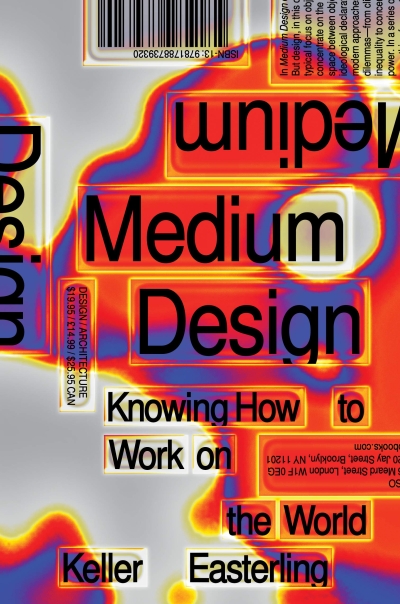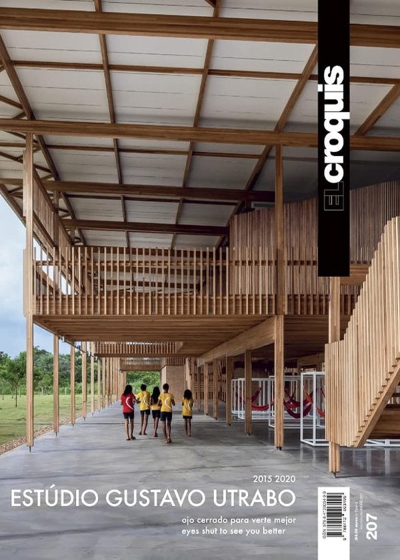gerade nicht auf Lager
Keller Easterling
Medium Design. Knowing How to Work on the World
El Croquis
El Croquis 207. Estudio Gustavo Utrabo
gerade nicht auf Lager
Experimental Jetset
Experimental Jetset. Superstructures. Notes on Experimental…
gerade nicht auf Lager
Claudia Mareis, Nina Paim (Hg)
Design Struggles. Intersecting Histories, Pedagogies, and…
gerade nicht auf Lager
Moises Puente, Antje Stahl, Nikolaus…
2G 81. Brandlhuber+
gerade nicht auf Lager
Georges Perec
Die dunkle Kammer. 124 Träume
gerade nicht auf Lager
Kristin Ross
Luxus für alle. Die politische Gedankenwelt der Pariser…
gerade nicht auf Lager
Victor Deupi, Jean-Francois Lejeune
Cuban Modernism. Mid-Century Architecture 1940–1970
gerade nicht auf Lager
Tom Holert
Politics of Learning, Politics of Space. Architecture and…
gerade nicht auf Lager
Eva von Redecker
Revolution für das Leben. Philosophie der neuen…
Nina Prader, John Z. Komurki (Eds.)
Druck Druck Druck. Print Communities from Berlin and Beyond
Herausgegeben:Bundesministerium des…
70 Jahre Kunst am Bau in Deutschland
Philippe Askenazy
Share the Wealth. How to End Rentier Capitalism
gerade nicht auf Lager
Andreas Malm
How to Blow Up a Pipeline
gerade nicht auf Lager
Liam Campling and Alejandro Colás
Capitalism and the Sea
Gerald Raunig
Ungefüge. Maschinischer Kapitalismus und molekulare…
Niki Kubaczek, Monika Mokre (Hg.)
Die Stadt als Stätte der Solidarität
gerade nicht auf Lager
Floris Alkemade, Michiel van Iersel,…
REWRITING ARCHITECTURE. 10+1 Actions. Tabula Scripta
Manuel de la Pena Suarez
Structuralism and Experimentation in the Architecture of…
gerade nicht auf Lager
Anaïs Wiedenhöfer & Lena Wolfart
Everyday Urban Design 4. Genossenschaftliche…
gerade nicht auf Lager
Emmanuelle Chiappone-Piriou (Ed.)
Superstudio Migrazioni
Tim Ingold
Eine kurze Geschichte der Linien
gerade nicht auf Lager
Christoph Herndler, Florian Neuner (Hg.)
Der unfassbare Klang. Notationskonzepte heute
gerade nicht auf Lager
Fredric Jameson
The Benjamin Files
gerade nicht auf Lager
Adam Štěch
Modern Architecture and Interiors
gerade nicht auf Lager
Gabrielle Kenndy (Hg)
In/Search Re/Search. Imagining Scenarios Through Art and…
gerade nicht auf Lager
Diedrich Diederichsen, Oier Etxeberria…
Cybernetics of the Poor
gerade nicht auf Lager
Paul Hegarty
Annihilating Noise
gerade nicht auf Lager
John Beck
Landscape as Weapon. Cultures of Exhaustion and Refusal
Axel Sowa, Ela Kacel (eds.)
Candide. Journal for Architectural Knowledge / No. 12
Douglas Spencer
Critique of Architecture: Essays on Theory, Autonomy, and…
Hansuli Matter, Björn Franke (eds.)
Not at Your Service. Manifestos for Design
gerade nicht auf Lager
Brandon LaBelle
Acoustic Justice: Listening, Performativity, and the Work…
gerade nicht auf Lager
Precarity Lab
Technoprecarious
gerade nicht auf Lager
Annette Maechtel
Das Temporäre politisch denken. Raumproduktionen im Berlin…
gerade nicht auf Lager
Cornelia Sollfrank, Felix Stalder,…
Aesthetics of the Commons
gerade nicht auf Lager
Mark Wigley
Konrad Wachsmann’s Television. Post-architectural…
gerade nicht auf Lager
Hans-Rudolf Meier
Spolien. Phänomene der Wiederverwendung in der Architektur
gerade nicht auf Lager
Erich Hörl, Nelly Y. Pinkrah, Lotte…
Critique and the Digital
Bradley Quinn
The Fashion of Architecture
Florian Rötzer
Sein und Wohnen. Philosophische Streifzüge zur Geschichte…
gerade nicht auf Lager
Philipp Stamm
Schrifttypen – Verstehen Kombinieren Schriftmischung als…
gerade nicht auf Lager
Gemma Villegas
Fanzine GRRRLS. The DIY Revolution in Female Self-Publishing
dérive
dérive N° 82, Sampler (Jan - Mar 2021)
Andreas H. Apelt, Ron Jagers
Hinter der Stille. Berlin-Prenzlauer Berg 1979-1989
Giseke, Löw, Million, Misselwitz,…
Urban Design Methods
gerade nicht auf Lager
Kengo Kuma
Kengo Kuma. My Life as an Architect in Tokyo
gerade nicht auf Lager
Elske Rosenfeld, Suza Husse (Hg.)
wildes wiederholen. material von unten. Dissidente…
gerade nicht auf Lager
Lukas Feireiss, Tatjana Schneider,…
Living the City. Of Cities, People and Stories
gerade nicht auf Lager
Stefan Rettich, Sabine Tastel (Hg.)
Die Bodenfrage. Klima, Ökonomie, Gemeinwohl
Caspar Stracke (Ed.)
Godard Boomerang. Artists on Godardian Conceptualism
Kai van Eikels
Synchronisieren. Ein Essay zur Materialität des Kollektiven
gerade nicht auf Lager
Johnny Golding, Martin Reinhart, Mattia…
Data Loam. Sometimes Hard, Usually Soft. On the Future of…
gerade nicht auf Lager
Hendrik Weber
Italic. What gives Typography Its emphasis
Tibor Joanelly
Shinoharistics. An Essay About a House
gerade nicht auf Lager
Thomas Moynihan
X-Risk. How Humanity Discovered Its Own Extinction
Bert Rebhandl
Jean-Luc Godard. Der permanente Revolutionär
Heide Schlüpmann
Raumgeben - der Film dem Kino
gerade nicht auf Lager
Antonio Lucci, Esther Schomacher, Jan…
Italian Theory
gerade nicht auf Lager
Harun Farocki
HaFI 013: Zur Geschichte der Arbeit. Dokument, Material…
gerade nicht auf Lager
Rebekka Ladewig, Angelika Seppi
Milieu Fragmente. Technologische und ästhetische…
gerade nicht auf Lager
Bonaventure Soh Bejeng Ndikung
In a While or Two We Will Find the Tone
gerade nicht auf Lager
Michelle Christensen, Jesko Fezer,…
Lechts und Rinks. Auseinandersetzungen mit dem Design der…
Jesko Fezer, Anita Kaspar, Andreas…
Displaying Political and Cultural Concerns. Kooperative für…
gerade nicht auf Lager
Francois Laruelle
The Last Humanity. The New Ecological Science
Jessica Morgan, Dorothea von Hantelmann…
Resource Hungry. Our Cultured Landscape and its Ecological…
Kathrin Röggla
Bauernkriegspanorama
gerade nicht auf Lager
Andreas Malm
Wie man eine Pipeline in die Luft jagt. Kämpfen lernen in…
gerade nicht auf Lager
Murray Shanahan
Die technologische Singularität
Nicolas Bourriaud
Exform
gerade nicht auf Lager
Philip Kurz (Hg.)
Meisterhaus Kandinsky Klee. Die Geschichte einer…
gerade nicht auf Lager
Beatrice von Bismarck, Benjamin Meyer-…
Curatorial Thing (Cultures of the Curatorial 4)
Louise Michel
Die Pariser Commune
Xiaowen Zhu
Oriental Silk
gerade nicht auf Lager
Sebastian Schipper, Lisa Vollmer (Hg.)
Wohnungsforschung. Ein Reader
gerade nicht auf Lager
Sally Stein, Ina Steiner (eds.)
Allan Sekula, Art Isn't Fair: Further Essays on the…
gerade nicht auf Lager
Tim Jordan
The Digital Economy
gerade nicht auf Lager
Juliane Rebentisch
Camp Materialism
Andrea Büttner
Shame
gerade nicht auf Lager
Amelie Von Wulffen
Collected Comics 2010-2020
Benjamin Fellmann, Bettina Steinbrügge…
Klassenverhältnisse. Phantoms of Perception
gerade nicht auf Lager
Itohan Osayimwese
Colonialism and Modern Architecture in Germany
gerade nicht auf Lager
Sharon Zukin
The Innovation Complex. Cities, Tech, and the New Economy
Sebastian Strombach
Verrückt. Der Comic zum Berliner Schloss
Hg von Erika Thümmel, FH JOANNEUM…
Die Sprache der Räume. Eine Geschichte der Szenografie
Stephan Trüby
Rechte Räume: Politische Essays und Gespräche (Bauwelt…
gerade nicht auf Lager
Malcolm James
Sonic Intimacy. Reggae Sound Systems, Jungle Pirate Radio…
gerade nicht auf Lager
AAPK – Suyoung Ko, Yeon Joo Oh, Soonam…
Architecture as Fabulated Reality
gerade nicht auf Lager
Anna Bokov
Avant-Garde as Method. Vkhutemas and the Pedagogy of Space…
gerade nicht auf Lager
Günter Karl Bose
Elementum. Über Typografie, Bücher und Buchstaben
gerade nicht auf Lager
Lorenzo Marsili
Planetary Politics. A Manifesto
Miriam Rasch (ed.)
Let’s Get Physical: A Sample of INC Longforms, 2015-2020
Cache
Gegen|Wissen. Cache 01
gerade nicht auf Lager
Angelika Fitz, Karoline Mayer,…
Boden für Alle
gerade nicht auf Lager
Silvia Benedito
Atmosphere Anatomies. On Design, Weather, and Sensation
gerade nicht auf Lager
Jan Reetze
Times & Sounds. Germany's Journey from Jazz and…
Frieder Butzmann
Wunderschöne Rückkopplungen
gerade nicht auf Lager
Ludger Hovestadt, Urs Hirschberg,…
Atlas of Digital Architecture.Terminology, Concepts,…


































































































